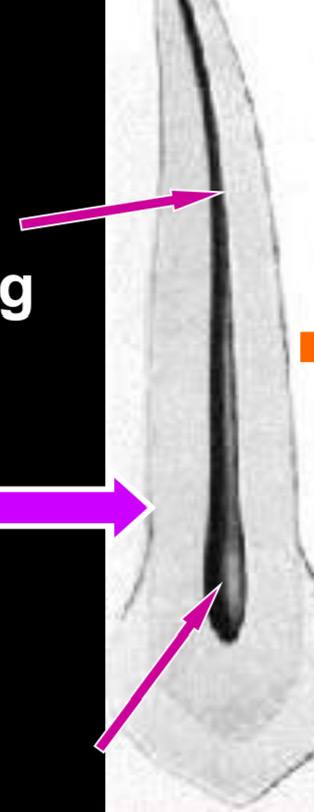maxillary permanent canine -- 2
1/14
Earn XP
Description and Tags
pulp chamber and roots
Name | Mastery | Learn | Test | Matching | Spaced |
|---|
No study sessions yet.
15 Terms
for root canals, what shape should be done for canines?
oval
how many pulp horns does the pulp chamber of a canine tooth contain?
it typically contains one
pulp cavity from mesio-distal section
narrow pulp chamber
root canal is long and tapers into the apical foramen

the pulp cavity from labiolingual section
the pulp chamber is pointed incisally and almost triangular in shape
root canal starts wide cervically until about the middle, and then it narrows to the apical foramen
at what aspect is the root canal wider?
it is wider at the labiolingual aspect
what is the average length of the tooth? what are minimum and maximum lengths? what is the range?
average: 26.5
maximum: 28.9
minimum: 23.9
range 5.8
the majority of canals in canines are what?
96.5% contain one canal
only 3.5% contain two canals
what is the percentage of lateral canals in the canines?
24%
what is different percentages of root curvature in the canines?
39% are straight, which is the highest amount
32% are distally curved
0% are mesially curved
13% are labially curved
7% are lingually curved
7% are bayonet and gradually curved
canal is typically what?
they are typically straight, though some show a distal apical curve (32%)
what is the shape of the root cross-sectioned?
in cervical and middle thirds, the canal is ovoid in shape
in apical third, they are circular in shape at the apex
what can the lingual surface of a maxillary canine exhibit?
on rare occasions, they may exhibit a tubercle, which is near the most incisal level of the cingulum
when a tubercle is present, what is most often associated with it?
a lingual pit
what is root form subject to?
many variations. there may be several curvatures along its length
since the maxillary canine erupts after maxillary premolars, what are two scenarios that can happen?
its space can become partially closed, leading it to erupt too closely to the labial or lingual surface of other teeth
or it may not erupt at all. both of these cases are known as impacted teeth